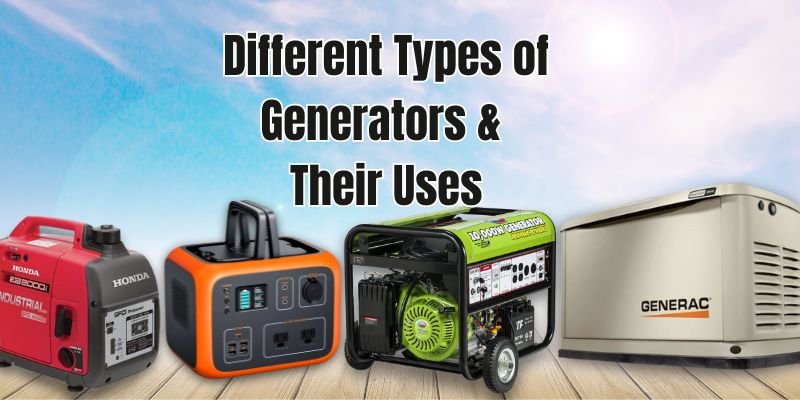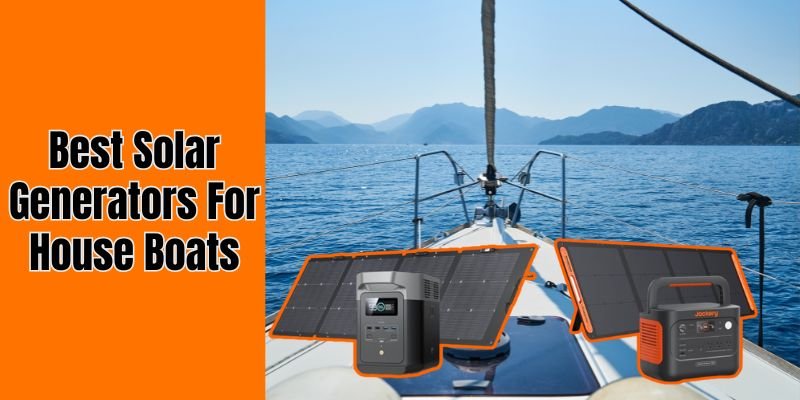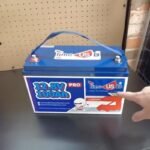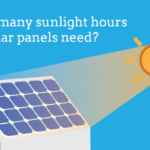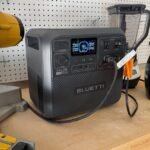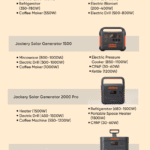Disclosure: This post contains affiliate links and I will be compensated if you make a purchase after clicking through my links. Learn More
Wiring a generator to a house with solar panels can be tricky. It requires careful planning and understanding of electrical systems.
This process involves connecting the generator to your home’s electrical system while integrating with solar panels. Properly wiring these systems ensures your home can use generator power during outages and solar energy when available. It also helps prevent backfeeding, which can be dangerous.
This guide will walk you through the steps needed to safely and effectively wire a generator to a house with solar panels. Whether you’re preparing for emergencies or maximizing energy efficiency, the right setup is crucial. Let’s explore how to achieve this balance in your home.
Introduction To Wiring A Generator
Connecting a generator to a house with solar panels involves understanding both systems. This knowledge ensures safety and efficiency. Let’s explore the basics of wiring a generator to your solar-powered home.
Importance Of Backup Power
Backup power is crucial during outages. Solar panels rely on sunlight. At night or during cloudy days, they produce less energy. A generator can fill this gap. It ensures your home remains powered. This is especially important for essential appliances. Think of your fridge, heating, or medical equipment. Reliable backup power keeps you comfortable and safe.
Basic Principles Of Electrical Wiring
Understanding electrical wiring basics is essential. Wiring a generator involves connecting it to your home’s electrical system. This process requires a transfer switch. The transfer switch prevents backfeeding. Backfeeding can be dangerous. It can harm utility workers and damage your generator.
First, locate your main electrical panel. This is where you’ll connect the transfer switch. Next, run wires from the generator to the switch. Use the correct wire gauge. Follow the manufacturer’s instructions closely. Safety is paramount.
Finally, test the system. Ensure the generator powers the house correctly. Check that the solar panels and generator do not interfere. Proper wiring keeps everything running smoothly. It also prevents potential hazards.
Tools And Materials Needed
Properly wiring a generator to a house with solar panels requires essential tools like wire cutters, pliers, and a voltage tester. Necessary materials include heavy-duty cables, connectors, and a transfer switch for seamless integration.
Wiring a generator to a house with solar panels might seem daunting, but with the right tools and materials, you can make the process smoother and more efficient. Whether you’re a seasoned DIYer or a beginner, having a clear list of what’s needed can save you time and hassle. Let’s dive into the essential tools and materials you’ll need to get started.
Essential Tools
Having the right tools is crucial for a successful project. Here’s a list of essential tools you’ll need:
– Screwdrivers: Both flathead and Phillips-head screwdrivers are necessary for loosening and tightening screws.
– Pliers: Needle-nose pliers can help you handle small wires, while larger pliers can assist with bigger components.
– Wire Strippers: These will help you strip the insulation off the ends of wires without damaging the copper inside.
– Multimeter: This is vital for checking voltages, continuity, and ensuring your connections are safe.
– Drill: Necessary for making holes to mount hardware or run wires through walls.
– Voltage Tester: Ensure all circuits are de-energized before you start working to avoid any electrical hazards.
– Wrench Set: Useful for tightening nuts and bolts, ensuring all connections are secure.
Have you used any of these tools before? If not, taking a few minutes to familiarize yourself can make a big difference in your confidence and efficiency.
Required Materials
Once you have your tools ready, gathering the necessary materials is your next step. Here’s what you’ll need:
– Generator Transfer Switch: This is a must-have for safely connecting your generator to your home’s electrical system.
– Cables and Wires: Make sure you have the appropriate gauge wires for your generator’s capacity and distance to the house.
– Connectors and Terminals: These help ensure that your wire connections are secure and reliable.
– Circuit Breakers: You may need additional circuit breakers to handle the load of the generator.
– Conduit: Protect your wires by running them through a conduit, which shields them from physical damage.
– Mounting Hardware: Screws, bolts, and brackets for securely mounting the generator and transfer switch.
– Electrical Tape: Essential for insulating and securing wire connections.
Do you have all these materials on hand? If not, a quick trip to your local hardware store can set you up for success.
Making sure you have the right tools and materials before you start can save you from unexpected trips to the store, which can be frustrating and time-consuming. It’s also a good idea to double-check everything before you begin. This preparation will help ensure a smoother, more efficient process when wiring your generator to your house with solar panels.
Safety Precautions
Ensure the generator and solar panels are disconnected from the house before wiring. Follow the manufacturer’s instructions closely. Use proper tools and protective gear for safety.
Wiring a generator to a house with solar panels can be a game-changer, especially during power outages. However, safety should always be your top priority. Taking the right safety precautions ensures that you, your family, and your property stay protected during the installation and operation.
Personal Protective Equipment
Before starting, make sure you have the right personal protective equipment (PPE). Always wear insulated gloves to protect against electric shocks. Use safety goggles to shield your eyes from sparks and debris.
Wear a hard hat if you’re working in an area where objects could fall. Sturdy, non-slip boots will keep you steady on your feet. PPE is not optional—it’s essential for your safety.
Electrical Safety Tips
Never work on electrical systems when the power is on. Turn off the main power supply before you start wiring. Double-check with a voltage tester to ensure there’s no live current.
Make sure your generator and solar panels are compatible. Consult the manuals or a professional if you’re unsure. Use proper wiring and connectors rated for the electrical load.
Keep water and moisture away from electrical components. Working in a dry environment reduces the risk of electric shock. If you ever feel uncertain, consult a licensed electrician.
Have you ever wondered what could go wrong if you skip safety steps? Ignoring them could lead to serious injuries or even fatalities. Safety isn’t just a formality—it’s a lifesaver.
By focusing on these safety precautions, you ensure a smoother, safer installation process. What other safety tips have you found useful in your DIY projects? Share your thoughts in the comments!
Understanding Your Solar Panel System
Understanding your solar panel system is essential before wiring a generator to your house. A solar panel system includes many parts that work together. Knowing these components and how they function will help you connect your generator correctly. Let’s dive into the basics.
Components Of A Solar System
A solar panel system consists of several key components. The main parts include solar panels, an inverter, and a battery bank. Solar panels collect sunlight and convert it into electricity. The inverter changes this electricity from DC (direct current) to AC (alternating current). The battery bank stores the electricity for later use.
Other components include a charge controller and wiring. The charge controller manages the flow of electricity to and from the battery. Proper wiring ensures all parts connect and work together smoothly. Understanding each part is crucial for integrating a generator into your system.
How Solar Panels Work
Solar panels generate electricity using sunlight. They contain photovoltaic cells that absorb sunlight and convert it into DC electricity. This electricity then flows to the inverter. The inverter changes the DC electricity into AC electricity. Your home uses AC electricity to power lights, appliances, and other devices.
On sunny days, solar panels produce more electricity than your home needs. The extra electricity goes into the battery bank. At night or on cloudy days, the battery bank provides power. This way, your home can use solar energy even when the sun isn’t shining.
Choosing The Right Generator
Wiring a generator to a house with solar panels needs careful planning. Ensure compatibility between the generator and solar system. Consult an expert for safe installation.
Choosing the right generator for your house, especially when you have solar panels, can be a game changer. It ensures your power supply is uninterrupted, even when the sun isn’t shining. With so many options available, it’s crucial to pick the right one for your needs.
Types Of Generators
There are various types of generators you can consider. Portable generators are a popular choice because they are versatile and easy to move around. They can be used for different purposes, from powering your home during a blackout to running a camping trip.
On the other hand, standby generators are permanently installed outside your home. They automatically kick in when the power goes out. This option is more convenient if you want a seamless transition during power outages.
Inverter generators are another excellent choice, especially if you have sensitive electronics. They provide cleaner and more stable power, ensuring your devices aren’t damaged.
Power Requirements
Understanding your power requirements is crucial. You need to determine the total wattage of the devices you plan to run with the generator. This includes everything from your refrigerator to your lights.
Make a list of all the essential appliances and their wattage. Add up these numbers to get a rough estimate of your total power needs. Remember, it’s always better to have a generator that provides a bit more power than your calculated requirement.
For example, if your total wattage comes to 5,000 watts, consider a generator that provides at least 6,000 watts. This ensures you won’t overload the generator and can run your essential appliances without issues.
Choosing the right generator involves careful consideration of these factors. Have you ever had to make this choice? What did you find most challenging?

Credit: www.youtube.com
Planning The Wiring Layout
Planning the wiring layout for connecting a generator to a house with solar panels is crucial. It ensures a safe and efficient power setup. This involves assessing your home’s electrical load and designing a wiring diagram that integrates both power sources effectively.
Assessing Your Home’s Electrical Load
Start by calculating your home’s total electrical load. List all appliances and devices that need power. Note their wattage and usage hours. This helps determine the size of the generator required. Remember, peak load times demand more power.
Next, consider your solar panel output. Check the average daily energy production. Compare this with your home’s daily energy consumption. This helps balance power supply from both sources. Ensure your generator can handle the extra load when solar power is insufficient.
Designing The Wiring Diagram
Begin sketching your wiring diagram. It should clearly show connections between the generator, solar panels, and household circuits. Use symbols to represent components like transfer switches, inverters, and circuit breakers.
Indicate the main power lines and their paths. Ensure you include safety devices like surge protectors and fuses. These prevent electrical hazards and protect your equipment. Plan for an automatic transfer switch. This device switches power sources seamlessly during outages.
Finally, review your diagram for accuracy. Double-check all connections and components. This step ensures a reliable and safe wiring layout. Consult a licensed electrician if needed. They can verify your plan and provide professional advice.
Connecting The Generator To The House
Connecting a generator to your house with solar panels ensures a reliable power supply. This setup provides backup power during outages or cloudy days. Here’s how to connect the generator to your home.
Installing The Transfer Switch
First, install a transfer switch. This device prevents back-feeding power to the grid. It’s crucial for safety. Start by turning off the main power supply. Next, choose a suitable location near the electrical panel. Secure the transfer switch to the wall. Use screws and a drill. Connect the transfer switch to the electrical panel. Follow the manufacturer’s instructions carefully. Ensure all connections are tight and secure.
Wiring The Generator To The Electrical Panel
Now, wire the generator to the electrical panel. Begin by turning off the generator. Locate the outlet on the generator. Connect a heavy-duty extension cord to this outlet. Run the cord to the transfer switch. Plug it into the designated inlet.
Turn on the generator. Switch the transfer switch to the generator position. This action diverts power from the generator to the house. Check each connection. Ensure everything functions correctly. Test the setup. Make sure the house receives power from the generator.

Credit: www.reddit.com
Integrating Solar Panels With The Generator
Combining a generator with solar panels can ensure your home always has power. This setup helps in times when solar power isn’t enough. This guide will show you how to integrate both systems smoothly.
Using An Inverter
An inverter is key to combining solar panels and a generator. It changes the solar power from DC to AC. This makes it usable for your home appliances.
Choose an inverter that can handle the power from both sources. Connect the solar panels to the inverter first. After that, link the generator to the inverter. This setup ensures a steady power supply.
Setting Up Battery Storage
Batteries store extra power from your solar panels. This stored energy can be used when there is no sunlight. Choose batteries that can store a large amount of power.
Connect the batteries to the inverter. Ensure the batteries are fully charged before you need them. They provide backup power when the generator is not running.
Testing And Maintenance
Connecting a generator to a house with solar panels requires careful testing and maintenance. Ensure all connections are secure and systems are compatible. Regularly check for faults to maintain efficiency.
When you wire a generator to a house with solar panels, testing and maintenance are crucial steps. They ensure your setup runs smoothly and safely. Ignoring these steps can lead to electrical hazards or inefficiencies. Here’s how to handle the testing and maintenance of your generator and solar panel system.
Initial Testing Procedures
First, turn off all power sources. This includes your main power supply, generator, and solar panels. Safety is paramount.
Next, use a multimeter to check voltage and connections. Ensure everything is wired correctly. This will prevent any unexpected power surges.
Turn on the generator and gradually introduce the load. Watch for any irregularities. If the lights flicker or you hear unusual sounds, turn everything off and recheck your connections.
Finally, test the transfer switch. Switch between the generator and solar power. This ensures a seamless transition when needed.
Regular Maintenance Tips
Maintenance keeps your system efficient. Check your generator’s oil levels monthly. Low oil can lead to engine damage.
Inspect the solar panels for dirt or debris. Clean them regularly. Dirty panels reduce efficiency.
Examine all wiring connections. Loose connections can cause electrical fires. Tighten them as needed.
Test your system every three months. This helps you catch small issues before they become big problems.
Keep a log of all maintenance activities. This helps you track what has been done and when.
By following these simple steps, you can keep your generator and solar panel system running smoothly. What’s your biggest challenge with maintaining your setup? Share your thoughts in the comments!
Frequently Asked Questions
Can I Connect A Generator To My House With Solar Panels?
Yes, you can connect a generator to your house with solar panels. Use a transfer switch for safety. Consult a professional electrician for proper installation. This ensures seamless operation and prevents backfeeding.
How To Combine Solar And Generator?
To combine solar and generator, install a hybrid inverter. Connect solar panels and generator to the inverter. Use a battery bank for energy storage. This setup ensures efficient power management and backup during low sunlight.
How Does A Generator Work With Solar Panels?
A generator works with solar panels by providing backup power when solar energy is insufficient. It ensures continuous electricity supply during cloudy days or at night. The system switches between solar panels and the generator automatically, maintaining power flow without interruption.
How To Connect A Generator To Your House Without A Transfer Switch?
Use an interlock kit to connect the generator. Ensure proper grounding for safety. Plug the generator into an outdoor outlet. Switch off the main breaker before connecting.
Final Words
Wiring a generator to a house with solar panels requires careful planning. Safety comes first. Follow the steps to ensure seamless integration. Check local codes and guidelines. Use the right equipment for the job. Regular maintenance keeps the system efficient.
A well-wired setup provides reliable backup power. Stay prepared for outages. Your home can benefit from both solar and generator energy. Keep your family safe and comfortable.

